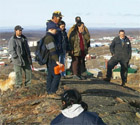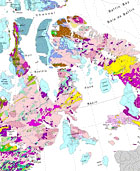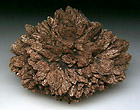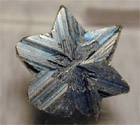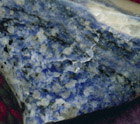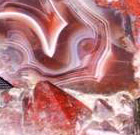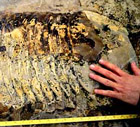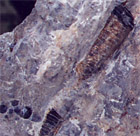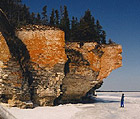 |
|||
|
|||
|
Winter/Spring 2001 Volume 5, Number 1
Editor's Notebook
By John Thomas
Nunavut was formed in April 1999. This huge territory consists of several mineral localities that are well known to mineral collectors in Canada and around the world. Several individuals from Iqaluit have started a new club to learn more about geology and to collect information and resources on the region.
The geology of Nunavut records almost three-billion years of Earth history, and some of the world's oldest known rocks have been found here. Our understanding of this history is the result of many years of study that began with the Geological Survey of Canada's great helicopter reconnaissance operations of the 1950's and 1960's.
Nunavut Territory possesses a number of interesting mineral localities, a few of which that are well known to professional collectors in Canada and around the world. This article introduces Nunavut to the mineral collector seeking to learn more about Canada's mineral localities, and to encourage the collection and appreciation of the various fine and rare minerals from this northernmost region of Canada.
By David Joyce and Dirk Schmid
Cubanite occurs in copper-zinc deposits. A few well-crystallized cubanite specimens were recently found at the Thompson Mine, near Thompson, Manitoba.
The Craigmont Mine was British Columbia's first large-scale open-pit mine. At one point during the early 1960's, the Craigmont extracted up to 50,000 tones of copper ore per day. This article looks at the mine, its operations, and some of the many minerals found there.
Sodalite is considered relatively rare since there are only three large deposits known in the world. One of these deposits, the Princess Sodalite Mine, is located only two and a half miles east of the town of Bancroft in Hastings County, Ontario.
By Edgar George Pye
Some rock or mineral specimens are special in that they reflect interesting events, and sometimes events of historical interest. As resident geologist for the Districts of Thunder Bay and Rainy River during the 1950's, I was sometimes the recipient of an unusual sample that was destined to attract the attention of the press. Here are a few memorable samples.
Campbellton is a small port city located along the south shore of Baie des Chaleurs in northern New Brunswick. In this area one can find agate and various interesting fossils. The jasper from this area occurs in huge chunks along the shoreline. Rockhounds will enjoy collecting in this mountainous region of New Brunswick.
Manitoba Museum now home to World's Biggest Trilobite
A team of Canadian paleontologists working in northern Manitoba recently discovered the world's largest recorded complete trilobite fossil. The 445 million-year-old fossil, which measures 72 centimetres in length, has found a new home at the Manitoba Museum of Man and Nature in Winnipeg, Manitoba.
Southeast of Chilliwack, British Columbia, a short section of Slesse Creek passes through some of the oldest fossil-bearing rock in B.C. The leading fossils in this area are stems of crinoids, marine invertebrate organisms that lived during the Permian period.
About 80 million years ago Manitoba was covered by a shallow sea that was inhabited by mosasaurs and plesiosaurs. Giant squid also swam these ancient waters. Fossilized remains of extinct giant squid have been recently excavated from the bentonite quarries near Morden, Manitoba.
We recently developed a new synthetic fossil dig designed for children. The result was DinoDig. The value of allowing a child to take his/her discovery away, together with information on the specimen, cannot be underestimated.
Sir William Logan, founder of the Geological Survey of Canada and innovative cartographer
Sir William Logan achieved so much that his record seems almost beyond belief. He was the first to probe, study and name the Canadian Shield. He founded a geological museum that grew and expanded to become a major part of the National Museum of Canada. Logan's book, Geology of Canada, is the bedrock of Canadian geological study. He also produced an atlas and our first geological map.
Proposed National Park to Protect Manitoba's Lowlands
The Manitoba Lowlands region is among the most altered and threatened landscapes in the country. Situated between Lake Winnipeg and Lake Winnipegosis in central Manitoba, three areas contain a wide and impressive variety of fragile habitats, interesting geology, limestone carst caves and picturesque shorelines. Read why this area deserves protection.
Ammolite 2: A Guide for Gemmologists, Jewellers and Lapidaries
This new guidebook takes an intimate look at ammolite, Alberta's provincial gemstone. Dozens of exciting samples of this rare gem from rough material through to the finished jewellery are shown. Those who make ammolite jewellery will be interested in this new beautifully illustrated book.
|
|||||||||||||||||
 
Copyright © 2001 Canadian Rockhound
Back Issues |
News & Events |
Junior Rockhound
|
||||||||||||||||||

